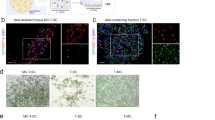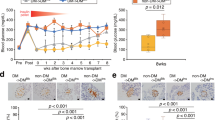Abstract
βTC-tet cells are conditionally immortalized pancreatic β cells which can confer long-term correction of hyperglycemia when transplanted in syngeneic streptozocin diabetic mice. The use of these cells for control of type I diabetes in humans will require their encapsulation and transplantation in non-native sites where relative hypoxia and cytokines may threaten their survival. In this study we genetically engineered βTC-tet cells with the anti-apoptotic gene Bcl-2 using new lentiviral vectors and showed that it protected this cell line against apoptosis induced by hypoxia, staurosporine and a mixture of cytokines (IL-1β, IFN-γ and TNF-α). We further demonstrated that Bcl-2 expression permitted growth at higher cell density and with shorter doubling time. Expression of Bcl-2, however, did not inter- fere either with the intrinsic mechanism of growth arrest present in the βTC-tet cells or with their normal glucose dose-dependent insulin secretory activity. Furthermore, Bcl-2 expressing βTC-tet cells retained their capacity to secrete insulin under mild hypoxia. Finally, transplantation of these cells under the kidney capsule of streptozocin diabetic C3H mice corrected hyperglycemia for several months. These results demonstrate that the murine βTC-tet cell line can be genetically modified to improve its resistance against different stress-induced apoptosis while preserving its normal physiological function. These modified cells represent an improved source for cell transplantation therapy of type I diabetes.
This is a preview of subscription content, access via your institution
Access options
Subscribe to this journal
Receive 12 print issues and online access
$259.00 per year
only $21.58 per issue
Buy this article
- Purchase on Springer Link
- Instant access to full article PDF
Prices may be subject to local taxes which are calculated during checkout








Similar content being viewed by others
References
Lanza RP et al. Xenotransplantation of canine, bovine, and porcine islets in diabetic rats without immunosuppression Proc Natl Acad Sci USA 1991 88: 11100–11104
Lum ZP et al. Prolonged reversal of diabetic state in NOD mice by xenografts of microencapsulated rat islets Diabetes 1991 40: 1511–1516
Soon-Shiong P et al. Long-term reversal of diabetes by the injection of immunoprotected islets Proc Natl Acad Sci USA 1993 90: 5843–5847
Soon-Shiong P et al. Insulin independence in a type 1 diabetic patients after encpasulated islet transplantation Lancet 1994 343: 950–951
Sun AM . Microencapsulation of cells. Medical applications Ann NY Acad Sci 1997 831: 271–279
Hering BJ et al. International islet transplant registry Newsletter 1996 6: 1–20
Fleischer N et al. Functional analysis of a conditionally transformed pancreatic beta-cell line Diabetes 1998 47: 1419–1425
Efrat S et al. Conditional transformation of a pancreatic beta-cell line derived from transgenic mice expressing a tetracycline-regulated oncogene Proc Natl Acad Sci USA 1995 92: 3576–3580
Benoist C, Mathis D . Cell death mediators in autoimmune diabetes – no shortage of suspects Cell 1997 89: 1–3
Delaney CA et al. Cytokines induce deoxyribonucleic acid strand breaks and apoptosis in human pancreatic islet cells Endocrinology 1997 138: 2610–2614
Nerup J et al. On the pathogenesis of IDDM Diabetologia 1994 37: S82–S89
Mandrup-Poulsen T . The role of interleukin-1 in the pathogenesis of IDDM Diabetologia 1996 39: 1005–1029
Bonner-Weir S, Orci L . New perspectives on the microvasculature of the islets of Langerhans in the rat Diabetes 1982 31: 883–889
Chang N, Goodson WHd, Gottrup F, Hunt TK . Direct measurement of wound and tissue oxygen tension in postoperative patients Ann Surg 1983 197: 470–478
Spokane R et al. An implanted peritoneal oxygen tonometer that can be calibrated in situ ASAIO Trans 1990 36: M719–M722
Kuhtreiber WM et al. Relationship between insulin secretion and oxygen tension in hybrid diffusion chambers ASAIO J 1993 39: M247–251
Schrezenmeir J et al. Effect of microencapsulation on oxygen distribution in islets organs Transplantation 1994 57: 1308–1314
Davalli AM et al. Vulnerability of islets in the immediate posttransplantation period. Dynamic changes in structure and function Diabetes 1996 45: 1161–1167
Carlsson PO, Liss P, Andersson A, Jansson L . Measurements of oxygen tension in native and transplanted rat pancreatic islets Diabetes 1998 47: 1027–1032
Dionne KE, Colton CK, Yarmush ML . Effect of hypoxia on insulin secretion by isolated rat and canine islets of Langerhans Diabetes 1993 42: 12–21
Naldini L et al. In vivo gene delivery and stable transduction of nondividing cells by a lentiviral vector (see comments) Science 1996 272: 263–267
Jacobson MD et al. Bcl-2 blocks apoptosis in cells lacking mitochondrial DNA Nature 1993 361: 365–369
Jacobson MD, Burne JF, Raff MC . Programmed cell death and Bcl-2 protection in the absence of a nucleus EMBO J 1994 13: 1899–1910
Vayssiere JL, Petit PX, Risler Y, Mignotte B . Commitment to apoptosis is associated with changes in mitochondrial biogenesis and activity in cell lines conditionally immortalized with simian virus 40 Proc Natl Acad Sci USA 1994 91: 11752–11756
Zheng DQ et al. Apoptosis is antagonized by large T antigens in the pathway to immortalization by polyomaviruses Oncogene 1994 9: 3345–3351
Shimizu S et al. Prevention of hypoxia-induced cell death by Bcl-2 and Bcl-xL Nature 1995 374: 811–813
Jacobson MD, Raff MC . Programmed cell death and Bcl-2 protection in very low oxygen Nature 1995 374: 814–816
Efrat S . Cell-based therapy for insulin-dependent diabetes mellitus Eur J Endocrinol 1998 138: 129–133
Zufferey R et al. Multiply attenuated lentiviral vector achieves efficient gene delivery in vivo Nat Biotechnol 1997 15: 871–875
Emerman M, Temin HM . Quantitative analysis of gene suppression in integrated retrovirus vectors Mol Cell Biol 1986 6: 792–800
Emerman M, Temin HM . Genes with promoters in retrovirus vectors can be independently suppressed by an epigenetic mechanism Cell 1984 39: 449–467
Zufferey R et al. Self-inactivating lentiviral vector for safe and efficient in vivo gene delivery J Virol 1998 72: 9873–9880
Donello JE, Loeb JE, Hope TJ . Woodchuck hepatitis virus contains a tripartite posttranscriptional regulatory element J Virol 1998 72: 5085–5092
Zufferey R, Donello JE, Trono D, Hope TJ . Woodchuck hepatitis virus posttranscriptional regulatory elements enhances expression of transgenes delivered by lentiviral vectors J Virol 1999 73: 2886–2892
Efrat S, Baekkeskov S, Lane D, Hanahan D . Coordinate expression of the endogenous p53 gene in beta cells of transgenic mice expressing hybrid insulin-SV40 T antigen genes EMBO J 1987 6: 2699–2704
Arnush M et al. IL-1 produced and released endogenously within islets inhibits β cell function J Clin Invest 1998 102: 516–526
Eizirik DL et al. Cytokines suppress human islet function irrespective of their effects on nitric oxide generation J Clin Invest 1994 93: 1968–1974
Hoorens A, Van de Casteele M, Kloppel G, Pipeleers D . Glucose promotes survival of rat pancreatice beta cells by activating synthesis of proteins which suppress a constitutive apoptotic program J Clin Invest 1996 98: 1568–1574
Iwahashi H et al. Cytokine-induced apoptotic cell death in a mouse pancreatic beta-cell line: inhibition by Bcl-2 Diabetologia 1996 39: 530–536
Liu Y et al. Expression of the bcl-2 gene from a defective HSV-1 amplicon vector protects pancreatic beta-cells from apoptosis Hum Gene Ther 1996 7: 1719–1726
Marconi P et al. Replication-defective herpes simplex virus vectors for gene transfer in vivo Proc Natl Acad Sci USA 1996 93: 11319–11320
Menger MD et al. Influence of experimental hyperglycemia on microvascular blood perfusion of pancreatic islet isografts J Clin Invest 1992 90: 1361–1369
Rodriguez I et al. Mouse vaginal opening is an apoptosis-dependent process which can be prevented by the overexpression of Bcl2 Dev Biol 1997 184: 115–121
Naldini et al. Efficient transfer, integration, and sustained long-term expression of the transgene in adult rat brains injected with a lentiviral vector Proc Nat Acad Sci USA 1996 93: 11382–11388
Charneau P et al. HIV-1 reverse transcription. A termination step at the center of the genome J Mol Biol 1994 241: 561–662
Kinsella TM, Nolan GP . Episomal vectors rapidly and stably produce high-titer recombinant retrovirus Hum Gene Ther 1996 7: 1405–1413
Pear WS, Nolan GP, Scott ML, Baltimore D . Production of high-titer helper-free retroviruses by transient transfection Proc Natl Acad Sci USA 1993 90: 8392–8396
Gremlich S, Roduit R, Thorens B . Dexamethasone induces posttranslational degradation of GLUT2 and inhibition of insulin secretion in isolated pancreatic beta cells. Comparison with the effects of fatty acids J Biol Chem 1997 272: 3216–3222
Wyllie AH, Morris RG . Hormone-induced cell death. Purification and properties of thymocytes undergoing apoptosis after glucocorticoid treatment Am J Pathol 1982 109: 78–87
Rinsch C et al. A gene therapy approach to regulated delivery of erythropoietin as a function of oxygen tension (see comments) Hum Gene Ther 1997 8: 1881–1889
Ricordi C, Scharp DW, Lacy PE . Reversal of diabetes in nude mice after transplantation of fresh and 7-day-cultured (24 degrees C) human pancreatic islets Transplantation 1988 45: 994–996
Acknowledgements
The authors thank S Efrat for many helpful discussions and suggestions during this work. The skilled technical assistance of Fabienne Hamburger, Nathalie Deriaz, Martine Vollenweider and Stephane Germain is gratefully acknowledged. We thank JC Martinou and I Rodriguez for providing the Bcl-2 cDNA. This work was supported by grant No 31-46958.96 from the Swiss National Science Foundation to BT and by a grant from Modex Thérapeutiques to BT.
Author information
Authors and Affiliations
Rights and permissions
About this article
Cite this article
Dupraz, P., Rinsch, C., Pralong, W. et al. Lentivirus-mediated Bcl-2 expression in βTC-tet cells improves resistance to hypoxia and cytokine-induced apoptosis while preserving in vitro and in vivo control of insulin secretion. Gene Ther 6, 1160–1169 (1999). https://doi.org/10.1038/sj.gt.3300922
Received:
Accepted:
Published:
Issue Date:
DOI: https://doi.org/10.1038/sj.gt.3300922
Keywords
This article is cited by
-
MRI-detectable pH nanosensors incorporated into hydrogels for in vivo sensing of transplanted-cell viability
Nature Materials (2013)
-
Lentivectors encoding immunosuppressive proteins genetically engineer pancreatic β-cells to correct diabetes in allogeneic mice
Gene Therapy (2009)
-
Beta cell apoptosis in diabetes
Apoptosis (2009)
-
Lentivirus-mediated gene transfer of viral interleukin-10 delays but does not prevent cardiac allograft rejection
Gene Therapy (2005)
-
Understanding of basic mechanisms of β-cell function and survival
Cell Biochemistry and Biophysics (2004)



